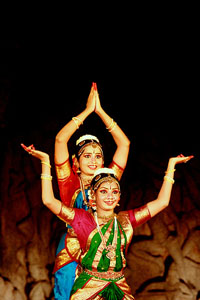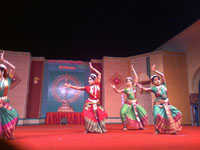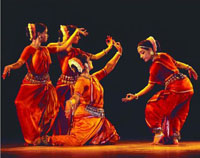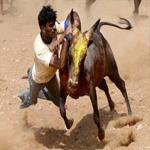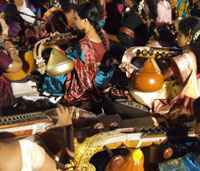| |
|
Tamil Nadu - Tamil Nadu Dance Festivals
Tamil Nadu is a state
at the southern tip of India. The bordering states/territories are Pondicherry,
Kerala, Karnataka and Andhra Pradesh. The island nation of Sri Lanka,
which has a significant Tamil minority, lies off the southeast coast.
Tamil Nadu has the Largest urban agglomeration nationwide and is the second most industrialized state in India. Unlike most other parts of the country, Tamil Nadu gets its rainfall largely from the "North-East monsoon" in the months of October-December. There is a long standing dispute with Karnataka over the matter of water from the Kaveri River. The river flows south from Karnataka to Tamil Nadu, and both regions draw on water from the river, prompting concerns over whether the upper riparian Karnataka has released its fair share of river water to the lower riparian Tamil Nadu.
| Time: January-February
|
| Duration: Four Weeks |
| Location: Mahabalipuram, Tamil Nadu |
Description:
Mamallapuram (Mahabalipuram)
during the reign of Pallavas, was a port town and is renowned for
its Rathas or temples in the form of chariots, Mandapas or cave
sanctuaries built by the Pallava rulers. Mamallapuram
is one of the World Heritage Sites declared by
the UNESCO. It also has a wonderful beach and makes
for an ideal tourist destination.
Mamallapuram Dance Festival
is organized every year from early January to first week of February
for a period of four weeks. Exponents of classical dances like Bharatnatyam,
Kuchipudi, Kathak, and Kathakali gather and perform in an open-air
stage against the backdrop of the Pallava rock sculptures.
Folk dancers add local touch to the festival. The renowned festival
is organized by the Department of Tourism, Government
of Tamilnadu.
This four week Mamallapuram
Dance Festival is held at the venue of Arjuna's penance,
a bass-relief sculpted on the face of two enormous adjacent rocks,
in Mamallapuram. The magnificent backdrop that
is provided by the Pallava Rock Sculptures provide
an aesthetic touch to this cultural dance festival.
The open-air stage and the dancers
from far and wide come to watch the best folk dancers in India perform
in front of them under the open skies in an open-air theatre style
ambience. This open-air stage was created about thirteen
centuries ago, the incredible monolithic rock sculptures
of the Pallavas, next to the sea in this ancient city of
Mamallapuram.
|
| Time: February
|
| Duration: Five Days |
| Location: Chidambaram, Tamil Nadu |
Description:
The Natyanjali festival, which
brings all the prominent dancers of India, together on the same
platform, opens on the auspicious occasion of Mahasivaratri,
in the month of February. Lord Nataraja, according to the Hindu
mythology is a cosmic dancer. He is called the Lord of dances.
This is an opportunity for all dancers, from all India, to perform
and to pay their tribute to Lord Nataraja.
It is performed at the 'Prakara' of the temple, and the dancers,
full of intense bliss and devotion, with their evocative performance,
offer their dance to the great divinity, Lord Nataraja. Natyanjali
festival is jointly organised by The Department of Tourism,
Government of Tamil Nadu, The Ministry Of Tourism, Government
of India and The Natyanjali Trust, Chidambaram. It is designed
to promote a universal message of 'Unity in Diversity' conveyed
in the universal language of music and dance.
|
| Time: Mid December-Mid January
|
| Duration: One Month |
| Location: Chennai, Tamil Nadu |
Description:
The Chennai Dance and Music
Festival is held every year in Chennai
from mid December to mid January. The month long musical extravaganza
is a celebration of classical music and dances
of South India and features performances by various artistes
from different parts of India. The festival is held at various venues
around the city. These include auditoriums, well-known temple premises
and heritage bungalows. The festival is popularly known as the `Margazhi
Festival of Dance and Music'. The Tamil month of `Marghazi'
is considered a sacred month by the Hindus and South Indian
classical music, which is devotional in nature, has been
a traditional form of worship from time immemorial.
The festival attracts Indians from
all over the world and gives a glimpse of our rich cultural
heritage. Performances include Vocal and Instrumental music,
Dance - solo and group. The festival provides wonderful opportunity
for upcoming artistes to display their talent. The city becomes
alive with the festival which has now developed into a cultural
extravaganza with more than 2000 participants. The music includes
songs in various South Indian languages like Tamil, Telugu and Kannada
and instruments like Flute, 'Veena' (a large string instrument)
'Goottuvadyam' (similar to Veena but without frets), 'Nagaswaram'
(pipe), 'Thavil' (percussion instrument), 'Mridangam' (drum), and
even 'Ghatam' (a mud pot).
The 'Margazhi festival of dance and music' started
early back in 1927; to commemorate the anniversary of Madras
Music Academy every December was later adopted by various
organizations, which held art festivals in different parts of the
city.
|
| Time: January
|
| Duration: One Day |
| Location: Madurai, Tamil Nadu |
Description:
Jallikattu or
Taming the bull, an evenment happening with Poongal, the Festival
of the harvest starting at 15 January every year.
'Jallikattu' is
kind of bull-fight, held in Madhrai, Tiruchirapalli
and Tanjore in Tamil Nadu. Bundles containing
money are tied to the horns of ferocious bulls, and unarmed villagers
try to wrest the bundles from them. Bullock cart races
and cock-fights are also held. Ballads, folk dances, dramas and
songs have rich cultural heritages. Myths and legends, festivals
and ceremonials have helped to fashion an exquisitely charming type
of handicrafts.
The products of Tamilnadu workmen cater to as much
beauty as to utility, which include metal-ware, wood carving, pottery,
leather goods, carpets, pith work, palam left products, etc. handloom
textiles both cotton and silk have won global appreciation. Cattle
are decorated with garlands, their horns colored, and mango leves
hung round their necks. Then they are led about in procession exempted
from all labor, and virtually, if not actually, worshipped.
|
| Time: January
|
| Duration: 8 days |
| Location: Thiruvaiyaru, Tamil Nadu |
Description:
Thyagaraja music festival,
as the name suggests, is celebrated in the memory of the great saint
cum musician Thyagaraja. It is held on an annual
basis in Thiruvaiyaru, Tamilnadu, where Thyagaraja exhausted his
whole lifetime and also attained Samadhi. The celebration is an
eight day long musical demonstrate, which is graced by the leading
Carnatic singers and musicians from all parts of the country. Thyagaraja
musical festival is usually hosted in the month of January.
The main draw of the Thyagaraja
music festival is the group presentation by the famous
musicians of the Pancharathna Krithis. To honor the works and pay
respect to the great saint Thyagraja, what can be a better idea
than the presentation of Pancharathna Krithis,
his five compositions that came to be popularly known as the five
gems. Thyagaraja is accepted for his five gems even today. He is
and will remain the role model for all those associated with Carnatic
music.
|
|
|
|
|

